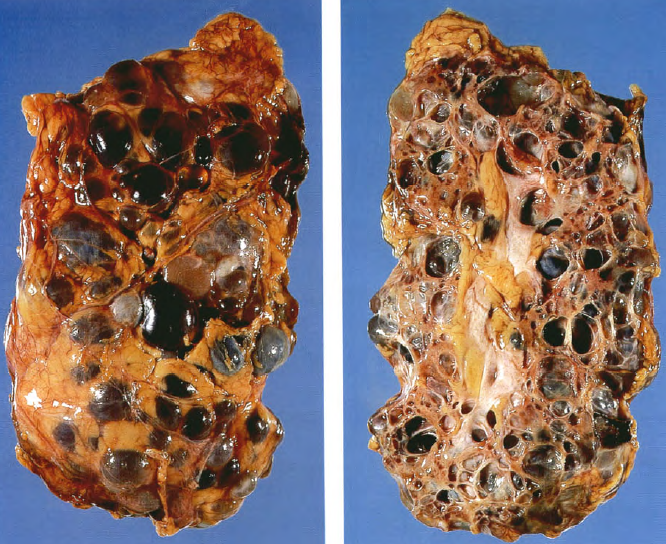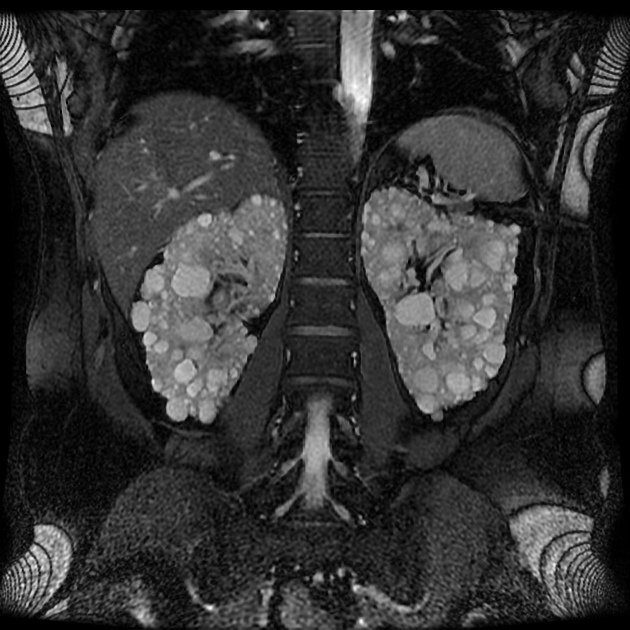Polycystic Kidney Disease (PKD)
Content of This Page
1- Introduction
2- Causes
3- Symptoms
4- Stages of The Disease
5- Treatment
6- What Should You Avoid
Introduction
Polycystic Kidney Disease (PKD) is a genetic disorder characterized by the growth of numerous cysts in the kidneys. These cysts are fluid-filled sacs that can enlarge the kidneys and impair their function, leading to kidney failure over time. There are two main types of PKD:
Autosomal Dominant PKD (ADPKD): The most common form, often manifesting in adulthood. It typically causes kidney enlargement, pain, high blood pressure, and eventually leads to kidney failure.
Autosomal Recessive PKD (ARPKD): A rarer and more severe form, usually apparent in infancy or early childhood. It can affect not only the kidneys but also the liver, leading to significant health challenges early in life.

Causes
Autosomal Dominant PKD (ADPKD):
- Genetic Mutation: ADPKD is caused by mutations in either the PKD1 or PKD2 gene. These genes are responsible for producing proteins that help maintain the structure and function of kidney cells. Mutations in these genes lead to the development of cysts.
- Inheritance: ADPKD is inherited in an autosomal dominant manner, meaning that if one parent has the condition, there’s a 50% chance of passing it on to their children.
Autosomal Recessive PKD (ARPKD):
- Genetic Mutation: ARPKD is caused by mutations in the PKHD1 gene, which affects the development of the kidneys and liver.
- Inheritance: ARPKD is inherited in an autosomal recessive manner, meaning both parents must carry a copy of the mutated gene for their child to develop the condition. If both parents are carriers, there is a 25% chance their child will have ARPKD.
Symptoms
-Autosomal Dominant PKD (ADPKD) :-
This form usually manifests in adulthood, and symptoms may include:
- High Blood Pressure: Often one of the first signs of ADPKD, high blood pressure can lead to further kidney damage if not managed.
- Pain: Chronic pain in the back, sides, or abdomen due to kidney enlargement or cyst rupture.
- Blood in Urine (Hematuria): This can occur when cysts rupture or due to kidney stones.
- Frequent Urinary Tract Infections (UTIs): Particularly in the kidneys.
- Kidney Stones: These can form as a result of impaired kidney function.
- Enlarged Abdomen: Due to the growing size of the kidneys.
- Kidney Failure: Over time, the kidneys may lose their ability to function, leading to end-stage kidney disease, which requires dialysis or a transplant.
- Other Symptoms: Cysts may also form in other organs like the liver, pancreas, and blood vessels in the brain, leading to complications.
-Autosomal Recessive PKD (ARPKD) :-
This form is usually evident at birth or in early childhood, with more severe symptoms, including:
- Enlarged Kidneys: The kidneys may be significantly enlarged at birth, leading to difficulty breathing in newborns.
- High Blood Pressure: Similar to ADPKD, but can appear early in life.
- Urinary Tract Infections: Frequent UTIs can occur.
- Impaired Kidney Function: Leading to reduced urine production and, in severe cases, kidney failure early in life.
- Liver Problems: Enlarged liver, fibrosis, and portal hypertension can occur due to cysts in the liver.
- Growth Issues: Children with ARPKD may experience delayed growth and developmental challenges.
- Breathing Problems: Due to the enlarged kidneys pressing on the lungs, particularly in newborns.
-Common Complications in Both Forms :-
- Aneurysms: Particularly in the brain, which can be life-threatening if they rupture.
- Heart Valve Abnormalities: Such as mitral valve prolapse.
- Diverticulosis: Small pouches in the colon wall that can become inflamed.

Stages of The Disease
1. Pre-Symptomatic Stage
- Characteristics:
- In this early stage, individuals may have cysts in the kidneys, but they are often small and few in number.
- Kidney function is typically normal, and there may be no noticeable symptoms.
- Detection:
- Often detected incidentally during imaging tests for other conditions or through genetic screening if there’s a family history.
2. Early Stage (Mild PKD)
- Characteristics:
- As cysts grow, some symptoms may begin to appear, such as mild high blood pressure.
- Kidney function remains relatively normal, but there may be slight increases in kidney size.
- Symptoms:
- Mild back or side pain.
- Slightly elevated blood pressure.
- Management:
- Focus is on monitoring and managing blood pressure to slow disease progression.
3. Intermediate Stage (Moderate PKD)
- Characteristics:
- Cysts increase in number and size, leading to noticeable kidney enlargement.
- Kidney function starts to decline, and symptoms become more pronounced.
- Symptoms:
- Increased blood pressure.
- More frequent pain in the back, sides, or abdomen.
- Occasional blood in the urine (hematuria).
- Recurrent urinary tract infections (UTIs) or kidney stones.
- Management:
- Close monitoring of kidney function.
- Aggressive management of blood pressure.
- Addressing complications like UTIs and kidney stones.
4. Advanced Stage (Severe PKD)
- Characteristics:
- Significant kidney enlargement and further decline in kidney function.
- Symptoms are more severe, and complications become more common.
- Kidney function may be moderately to severely impaired, though not yet at the stage of kidney failure.
- Symptoms:
- Severe pain and discomfort due to large cysts.
- Chronic high blood pressure.
- Frequent infections.
- Possible liver cysts and other organ involvement.
- Management:
- More intensive treatment to manage symptoms and complications.
- Possible consideration of therapies to slow cyst growth and kidney function decline.
5. End-Stage Renal Disease (ESRD)
- Characteristics:
- At this stage, kidney function is severely compromised, often less than 10-15% of normal.
- The kidneys can no longer adequately filter waste and maintain fluid balance, leading to kidney failure.
- Symptoms:
- Fatigue, nausea, vomiting, and swelling due to fluid retention.
- Severe hypertension.
- Uremia (buildup of waste products in the blood).
- Management:
- Dialysis to replace kidney function.
- Kidney transplantation as a long-term treatment option.
- Management of associated complications like cardiovascular issues.
Treatment
Lifestyle Changes:
- Weight Loss: Reducing excess weight can decrease symptoms.
- Positional Therapy: Sleeping on your side instead of your back.
- Avoiding Alcohol and Sedatives: These can relax throat muscles and worsen symptoms.
Continuous Positive Airway Pressure (CPAP):
- A machine that uses a hose connected to a CPAP mask to keep the airway open during sleep.
Positive Airway Pressure Therapy:
- BiPAP: Provides two levels of pressure (inhalation and exhalation) for more comfort.
Oral Appliances:
- Dental devices that reposition the lower jaw and tongue to keep the airway open.
Surgery:
- Uvulopalatopharyngoplasty (UPPP): Removal of excess tissue from the throat.
- Genioglossus Advancement (GA): Repositioning the tongue muscle attachment.
- Inspire Therapy: A surgically implanted device that stimulates the airway muscles to prevent collapse.
Treatment of Underlying Conditions:
- Managing conditions like heart failure or neurological disorders that contribute to central sleep apnea.
What Should You Avoid
- High-sodium foods
- High-protein diets
- Caffeine
- Smoking
- NSAIDs (e.g., ibuprofen, naproxen)
- Sugary drinks and excessive sugar intake
- Processed and junk foods
- Excessive alcohol consumption
- Over-the-counter herbal supplements without medical advice
- Dehydration (inadequate water intake)